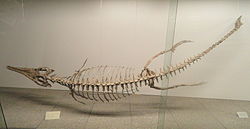| Thalattosuchus | |
|---|---|
 | |
| T. superciliosus, Senckenberg Museum of Frankfurt | |
| Scientific classification | |
| Kingdom: | Animalia |
| Phylum: | Chordata |
| Class: | Reptilia |
| Clade: | Archosauria |
| Clade: | Pseudosuchia |
| Clade: | Crocodylomorpha |
| Suborder: | † Thalattosuchia |
| Family: | † Metriorhynchidae |
| Subfamily: | † Metriorhynchinae |
| Genus: | † Thalattosuchus Young et al., 2020 [1] |
| Species: | †T. superciliosus |
| Binomial name | |
| †Thalattosuchus superciliosus (Blainville in Eudes-Deslongchamps, 1852) | |
| Synonyms | |
| |
Thalattosuchus is an extinct genus of marine crocodyliform that lived in the oceans during the Middle to Late Jurassic. Though the genus Thalattosuchus itself was named in 2020, its fossils have historically been included under the well known name Metriorhynchus as the species M. superciliosus, from which much of the research on the latter genus has been based upon. M. superciliosus was named as its own genus after a team of palaeontologists led by Mark Young in 2020 argued that the name Metriorhynchus could only be definitively applied to the type species, M. geoffroyii, and named Thalattosuchus ("sea crocodile", and from its parent group Thalattosuchia). [1] Not all researchers have accepted this split, and in 2022 another team led by Jonas le Mort have proposed Thalattosuchus be syonymised back into Metriorhynchus. [2]
Contents
Thalattosuchus was a carnivore that spent much, if not all, its life out at sea. No Thalattosuchus eggs or nests have been discovered, so little is known of the reptile's life cycle, unlike other large marine reptiles of the Mesozoic, such as plesiosaurs or ichthyosaurs which are known to have given birth to live young out at sea. [3] Where Thalattosuchus mated, whether on land or at sea, is currently unknown.


